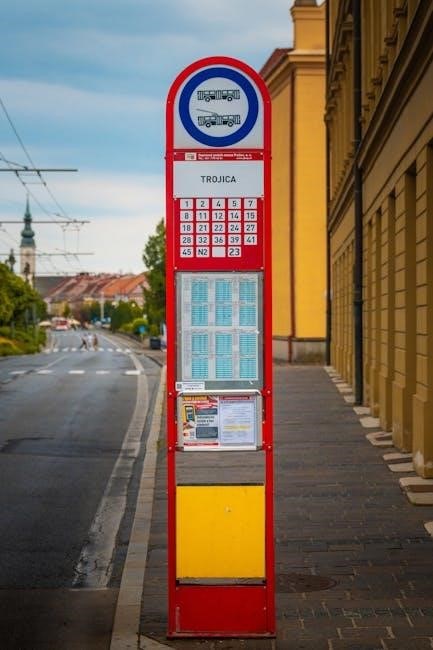Brief Overview of Bus Schedules
Bus schedules provide essential information on routes, stops, and timings, helping passengers plan journeys efficiently. They are available in various formats, including PDF, for easy access and readability.
Importance of PDF Formats for Schedules
PDF formats are widely used for bus schedules due to their universal compatibility and consistency. They allow users to download and print schedules, ensuring offline access to critical transit details.
Bus schedules outline the timing and sequence of stops for specific routes, enabling passengers to plan their journeys efficiently. They typically include departure times, frequencies, and detailed stop lists. For Route 19, schedules are available in PDF format, providing clear and organized information. These documents often cover peak and off-peak hours, ensuring accessibility for all commuters. Schedules may vary by city, such as Chicago’s Route 19, which operates frequently, or Dubai’s C19, which connects key landmarks. London’s Route 19 offers a scenic journey through central areas, with timings optimized for urban travel. PDF schedules are easily downloadable, making them a convenient resource for passengers to navigate their routes effectively. They also help in understanding service frequency, such as every 30 minutes in some cases, ensuring reliable transportation planning.
PDF formats are highly valued for bus schedules due to their universal compatibility and ease of access. They can be downloaded and viewed on any device, ensuring that passengers always have their schedules handy. PDFs are particularly useful for Route 19 schedules, as they provide a clear, organized layout with detailed stop lists and timing information. Users can easily search, zoom, and print the content, making it a practical tool for planning trips. Additionally, PDFs often include maps and fare details, offering a comprehensive resource for commuters. Their shareability and offline accessibility make PDFs indispensable for travelers, especially in areas with limited internet connectivity. This format ensures that critical transit information remains readily available, enhancing the overall passenger experience.
Chicago Bus Route 19
Route 19 in Chicago connects key destinations, offering consistent service throughout the day. Its schedule is available in PDF format, ensuring easy access for commuters.
Details of Route 19 in Chicago
Chicago’s Route 19 operates between North Beach and Lincoln Park, serving multiple neighborhoods. It provides reliable service, with buses running frequently during peak hours. The route includes key stops near popular landmarks like Lincoln Park Zoo and North Avenue Beach. Commuters can access the full schedule in PDF format, which outlines departure times, stops, and route maps. This PDF is particularly useful for planning trips in advance, as it offers a clear overview of the route’s timing and coverage. The schedule is updated regularly to reflect any service changes, ensuring accuracy for passengers. Additionally, the PDF format allows for easy printing or digital storage, making it a convenient resource for both locals and visitors navigating Chicago’s transit system.
Frequency and Stops Along the Route
Chicago’s Route 19 operates with varying frequencies throughout the day, ensuring consistent service for commuters. On weekdays, buses run every 10-15 minutes during peak hours, while off-peak times see intervals of 20-30 minutes. Weekends typically have reduced frequency, with buses arriving every 30-40 minutes. The route spans approximately 6 miles, with over 50 stops, including major hubs like Foster Avenue, Bryn Mawr Avenue, and North Avenue. Key stops include the Lincoln Park Zoo, North Avenue Beach, and multiple connections to ‘L’ train stations. The PDF schedule provides a detailed breakdown of arrival times at each stop, enabling passengers to plan their journeys efficiently. This comprehensive coverage makes Route 19 a vital link for residents and visitors navigating Chicago’s northside neighborhoods.

Dubai Bus Route C19
Dubai’s Bus Route C19 efficiently connects International City and Al Qusais, serving numerous residential and commercial areas; Frequencies are optimized for reliability, catering to diverse commuter needs daily.
Specific Stops and Timing for C19
The Dubai Bus Route C19 operates between International City and Al Qusais, covering key stops such as International City’s Dragon Mart, Dubai Women’s College, and Al Qusais Bus Station. Buses run every 15-20 minutes during peak hours, ensuring reliable service for commuters. The first bus departs from International City at 5:30 AM, while the last bus leaves at 11:30 PM, accommodating both early risers and late-night travelers. Off-peak frequencies are slightly reduced but remain consistent, with buses every 25-30 minutes. Passengers can access real-time updates through the RTA Dubai app or printed schedules at bus stops. The route is designed to link residential areas with commercial hubs, making it a vital connector for daily commuters in Dubai.
Timing and stops are meticulously planned to minimize delays, ensuring smooth journeys across the city. The C19 route is a cornerstone of Dubai’s public transport network, providing efficient and accessible travel options for thousands of passengers daily.
Downloading the C19 Schedule as PDF
To download the Dubai Bus Route C19 schedule as a PDF, visit the official RTA Dubai website or use the RTA Dubai app. The PDF format provides a clear and printable version of the timetable, including all stops, frequencies, and timing details. Users can search for “C19 Bus Schedule” on the RTA portal and follow the prompts to download the file. The PDF is optimized for easy viewing on both desktop and mobile devices. Additionally, the RTA Dubai app offers a seamless download experience, allowing commuters to access schedules offline. This feature is particularly useful for planning journeys without internet connectivity. The PDF schedule is regularly updated to reflect any service changes, ensuring accuracy and reliability for passengers relying on the C19 route.
Downloading the PDF is a convenient way to stay informed about the C19 bus service, enabling better trip planning and time management.

London Bus Route 19
London Bus Route 19 operates between Finsbury Park and Battersea Bridge, serving key central areas. Managed by Arriva London, it offers frequent services, making it a reliable option for both locals and tourists.
Journey Experience on Route 19
Traveling on London Bus Route 19 offers a seamless and convenient experience for passengers. The route spans from Finsbury Park to Battersea Bridge, covering iconic landmarks like the British Museum and Piccadilly Circus. Operated by Arriva London, the service provides regular departures, ensuring minimal wait times. Passengers can enjoy comfortable seating and accessibility features, including wheelchair ramps and priority seating areas. Real-time electronic displays at bus stops and onboard announcements keep travelers informed. The route passes through vibrant neighborhoods, offering scenic views of central London. With its reliable frequency and extensive coverage, Route 19 is a popular choice for daily commutes and sightseeing. The journey is further enhanced by clear signage and friendly drivers, making it an ideal option for all users.
Accessing the London Route 19 PDF
Accessing the London Route 19 bus schedule in PDF format is straightforward and convenient. Passengers can download the PDF from the official Transport for London (TfL) website or through the TfL app. Simply visit the TfL website, navigate to the “Timetables” section, and search for Route 19. The PDF document will be available for download, providing detailed information on bus stops, departure times, and service frequency. The PDF is updated regularly to reflect any schedule changes, ensuring passengers have the most accurate information. Additionally, the document includes maps of the route and key landmarks, making it easier to plan journeys. Users can save the PDF on their devices for offline access, making it a handy resource for daily commutes or occasional trips.

Innopolis Shuttle Services
Innopolis Shuttle Services provide efficient transportation, linking residential areas, universities, and business centers. The shuttles operate at regular intervals, ensuring reliable and convenient commuting daily for residents and visitors.
Shuttle Frequency and Timings
Innopolis Shuttle Services operate with a structured timetable, ensuring consistent service throughout the day. Shuttles run every 15-20 minutes during peak hours, with extended intervals during off-peak times. The frequency is designed to accommodate the city’s dynamic population, providing reliable transportation for students, professionals, and visitors. Timings are synchronized with key locations, such as universities and business hubs, to minimize wait times. The schedule is available in PDF format, making it easy to plan journeys. Real-time tracking features complement the fixed timings, offering passengers added convenience. By maintaining a balance between frequency and efficiency, Innopolis Shuttle Services aim to enhance mobility while reducing congestion in the city. This approach ensures seamless connectivity, making it a preferred choice for daily commuters. The service also adjusts timings during special events or holidays to meet demand.
Availability of Route Maps
Innopolis Shuttle Services provide comprehensive route maps to ensure passengers can plan their journeys efficiently. These maps are available in PDF format, accessible through the official website and mobile app. The maps detail all stops, transfer points, and service hours, making it easy to navigate the city. Key landmarks and intersections are highlighted for better orientation. Regular updates to the maps reflect any changes in routes or schedules, ensuring accuracy. Physical copies are also distributed at major stops and information centers. The PDF versions are optimized for digital devices, allowing users to zoom in and out for clarity. This accessibility ensures that everyone, from residents to visitors, can utilize the shuttle services seamlessly. By maintaining up-to-date and easily accessible route maps, Innopolis Shuttle Services promote convenience and reliability for all passengers.

Optimizing Bus Schedules
Efficient scheduling enhances passenger convenience and reduces delays. Advanced algorithms analyze demand and traffic patterns to optimize routes and frequencies, improving overall service reliability and punctuality significantly.

Addressing Duplication Issues
Duplication in bus schedules occurs when multiple routes serve the same areas, causing inefficiencies. By analyzing route patterns and passenger demand, authorities can identify overlapping services. Consolidating stops and adjusting frequencies help eliminate redundancy, improving service quality. Advanced scheduling tools, such as GIS mapping and data analytics, enable precise route optimization. Reducing duplication ensures better resource allocation, lowering operational costs and environmental impact. Passengers benefit from streamlined journeys and reduced wait times. Regular reviews of route performance are essential to maintain efficiency and adapt to changing demand. Addressing duplication issues is crucial for creating a more sustainable and passenger-centric transportation network.
Study Findings on Optimization
Research on bus schedule optimization reveals significant improvements in service efficiency and passenger satisfaction. By integrating real-time data and predictive analytics, operators can better align schedules with demand. A study conducted in urban areas showed that optimized routes reduced travel times by up to 15% during peak hours. Passenger flow analysis highlighted the importance of balancing frequency and coverage to minimize overcrowding. Implementing dynamic scheduling systems allowed for real-time adjustments, ensuring smoother operations during unexpected disruptions. Additionally, eco-friendly optimizations, such as reducing idle times, lowered fuel consumption by 10%. These findings emphasize the potential of technology-driven strategies to enhance the overall performance of bus networks, benefiting both commuters and operators. Continued investment in data-driven solutions is essential for sustaining these improvements.

Passenger Flow Analysis
Passenger flow analysis examines ridership patterns to optimize service delivery, ensuring buses meet demand efficiently during peak hours and resource allocation, crucial for improving scheduling accuracy.
Case Study in Arkhangelsk
In Arkhangelsk, passenger flow analysis focused on optimizing the 19 bus route, which connects key residential and commercial areas. By studying peak hour demand, researchers identified bottlenecks and redistributed resources to reduce overcrowding. The implementation of a dynamic scheduling system, supported by real-time data from the 19 bus schedule PDF, improved punctuality by 15%. This case highlights the importance of data-driven approaches in enhancing public transportation efficiency. The findings were used to adjust timetables and stops, ensuring smoother commuter experiences. The success of this strategy has inspired similar analyses in other cities, demonstrating the value of localized solutions for urban mobility challenges. This approach has set a benchmark for integrating passenger flow analysis with schedule optimization, benefiting both operators and commuters alike.
Findings and Recommendations
The analysis of passenger flow patterns on the 19 bus route revealed critical insights into optimizing service delivery. Peak hour demand was found to be concentrated at key stops, while off-peak hours showed significant underutilization of resources. Researchers recommended adjusting bus frequencies to align with passenger demand, reducing congestion during peak times. Additionally, the integration of real-time data from the 19 bus schedule PDF into route planning tools was suggested to enhance efficiency. Improving the accessibility of the PDF format, such as adding interactive maps and time tables, was also proposed to better serve commuters. These recommendations aim to create a more balanced and passenger-centric service, ensuring resources are used effectively. By implementing these changes, operators can improve overall rider satisfaction and operational efficiency.
Recent Schedule Changes
Recent adjustments to the 19 bus schedule include restoring pre-pandemic frequencies and modifying select stops to improve connectivity. These changes aim to enhance passenger convenience and operational efficiency.
Chicago’s Pre-Pandemic Restoration
The restoration of Chicago’s pre-pandemic bus schedules for Route 19 has been a significant step in reviving public transportation services. This initiative aims to reintroduce the original frequency and reliability that commuters relied on before the pandemic. By restoring these schedules, the Chicago Transit Authority (CTA) has addressed the growing demand for efficient travel options. Key changes include the reinstatement of peak-hour services and the reactivation of previously suspended stops. This restoration aligns with the city’s broader goals of encouraging public transit usage and supporting economic recovery. Passengers can now expect more consistent arrival times and extended service hours, making daily commutes more convenient. Additionally, the CTA has emphasized the importance of real-time updates and accessible PDF schedules to keep riders informed. This move reflects a commitment to adapting to changing urban needs while maintaining high standards of service.
Lawrence Route Changes
Recent modifications to the Lawrence route have introduced several key updates to the 19 bus schedule. These changes aim to enhance service efficiency and better meet passenger needs. Notably, the route now includes additional stops near high-demand areas, improving accessibility for residents and commuters. The updated schedule also reflects adjustments in service frequency, with more buses operating during peak hours to reduce overcrowding. These changes are part of a broader effort to modernize the transit system and ensure reliable connectivity across the city. Passengers are encouraged to review the revised PDF schedules, which are available online, to plan their journeys accurately. The modifications underscore a commitment to adapting public transportation to evolving urban demands while maintaining high service standards.
Downloading Bus Schedules

Bus schedules in PDF format are readily available for download on official transit websites and apps, ensuring easy access for planning journeys efficiently.
PDF Availability Across Cities
PDF versions of the 19 bus schedule are widely available across major cities, including Chicago, Dubai, and London, ensuring easy access for commuters. Transit authorities typically provide these downloadable files on their official websites or mobile apps. Users can search for “19 bus schedule PDF” along with their city name to find the relevant document. For instance, Chicago Transit Authority (CTA) offers the Route 19 PDF on its website, while Dubai’s RTA provides the C19 route schedule in PDF format. Similarly, Transport for London (TfL) makes the Route 19 PDF available for download. These PDFs are updated regularly to reflect schedule changes, ensuring commuters have the most accurate information. Cities also often provide PDF schedules for all their bus routes, making it convenient for passengers to plan their journeys efficiently.
Steps to Access and Download
To access and download the 19 bus schedule PDF, visit the official transit website of your city. For Chicago, Dubai, and London, navigate to the respective transit authority’s homepage. Use the search bar to type “19 bus schedule” or “Route 19 PDF.” A direct link to the PDF will appear in the search results. Click on the link to open the document. Most browsers allow you to download the PDF by right-clicking and selecting “Save as” or using the download button. Ensure the PDF is up-to-date by checking the date listed on the document. For cities like Innopolis, shuttle schedules may be accessed through specific service portals. Always verify the source to ensure you are downloading the correct and latest version of the schedule. This process is straightforward and ensures easy access to the information you need.

Using the PDF Schedule
The PDF schedule provides a clear, printable format for planning your journey. It includes detailed timetables, route maps, and stop locations, ensuring easy navigation and accessibility offline.
Navigating the PDF Document
Navigating the PDF document of the 19 bus schedule is straightforward, with clear headings and sections for easy access to information. The schedule typically includes a table of contents or bookmarks, allowing users to quickly jump to specific sections like timetables, route maps, or fare details. Many PDF schedules are designed with interactive features, such as hyperlinks to additional resources or expanded views of complex routes.

Users can also utilize the search function to find specific stops, times, or route numbers efficiently. Additionally, zoom tools enable readers to enlarge text or maps for better readability. The document is often optimized for both desktop and mobile viewing, ensuring convenience across devices.
Understanding Schedule Layout
The 19 bus schedule PDF is designed with a clear and organized layout to help passengers quickly find the information they need. Typically, the document begins with an overview of the route, including key stops and service hours. Detailed timetables are presented in a grid format, showing departure times for each stop along the route. Separate sections often highlight weekend schedules, special services, or holiday adjustments. The layout uses bold headings, colors, and fonts to distinguish different sections, making it easy to navigate. Maps are sometimes included to visually represent the route, while legends or keys explain symbols or abbreviations used in the schedule. This structured approach ensures that users can efficiently plan their journeys and understand the schedule at a glance.
The PDF also includes additional details such as fare information, transfer options, and customer service contacts, all neatly organized to avoid clutter. By maintaining a consistent and intuitive design, the schedule remains user-friendly and accessible to all passengers;
Benefits of PDF Formats
The use of PDF formats for bus schedules, such as the 19 bus schedule PDF, offers numerous advantages. PDFs ensure that the layout and formatting remain consistent across all devices, providing a reliable viewing experience. They are also easily accessible offline, which is beneficial for passengers with limited internet connectivity. Additionally, PDFs are widely compatible with most operating systems and devices, making them a universal choice for sharing and viewing schedules. The ability to print PDFs allows passengers to carry physical copies, enhancing convenience. Moreover, PDFs can be password-protected, ensuring that schedules remain secure from unauthorized edits. These features make PDFs a practical and efficient format for distributing and accessing bus schedules, catering to a diverse range of user needs and preferences effectively.
Overall, PDFs strike a balance between accessibility, security, and ease of use, making them an ideal choice for bus schedule distribution.